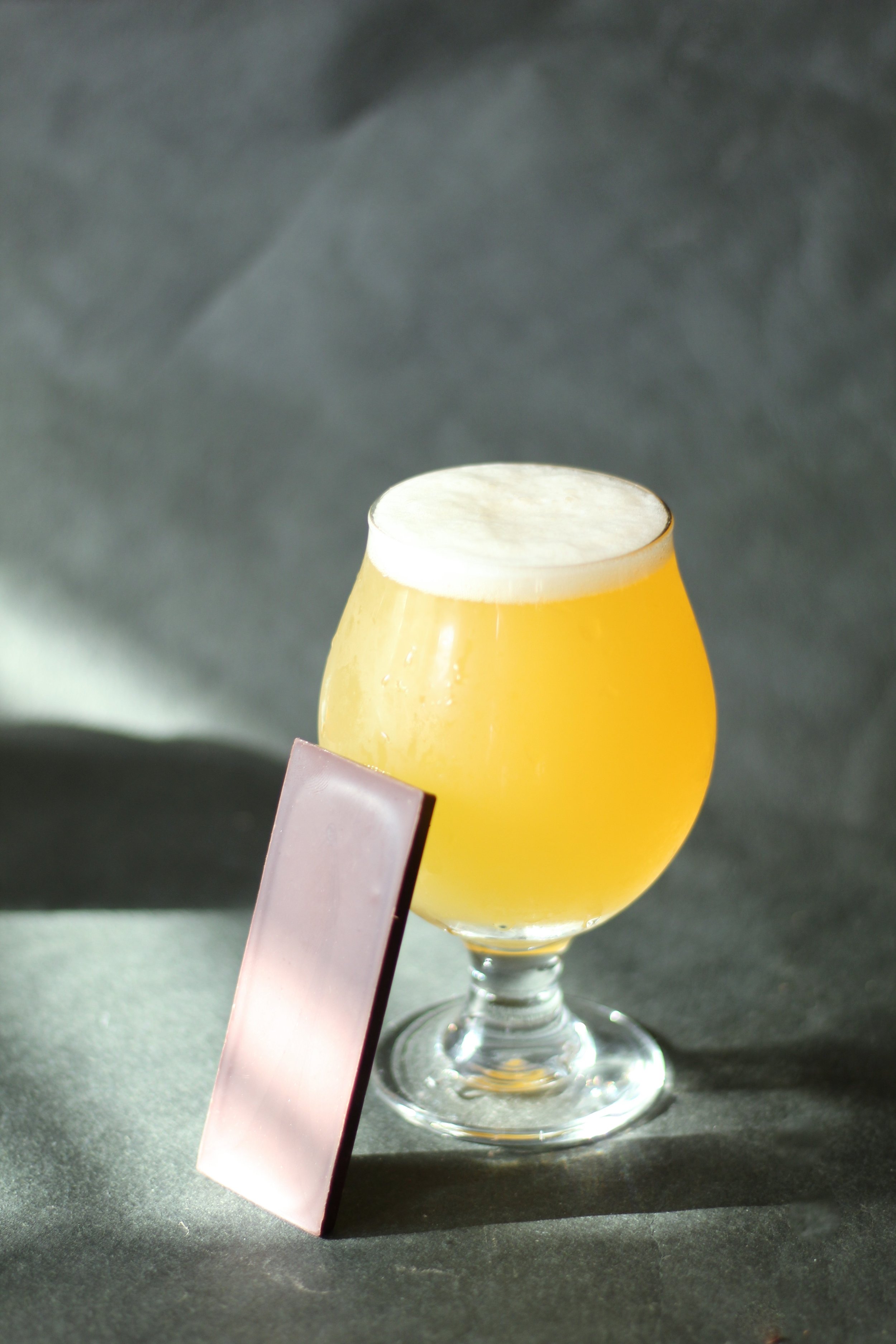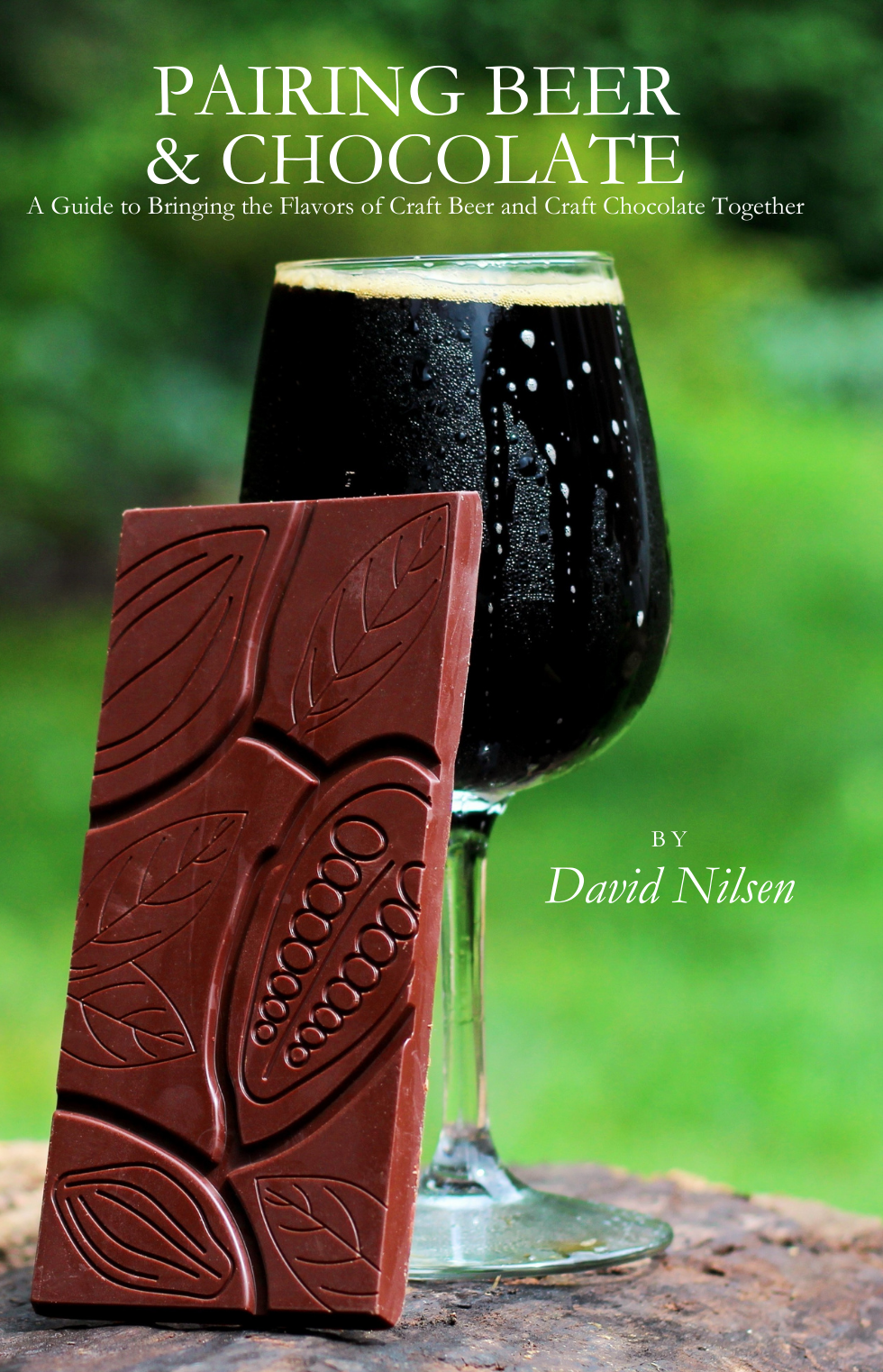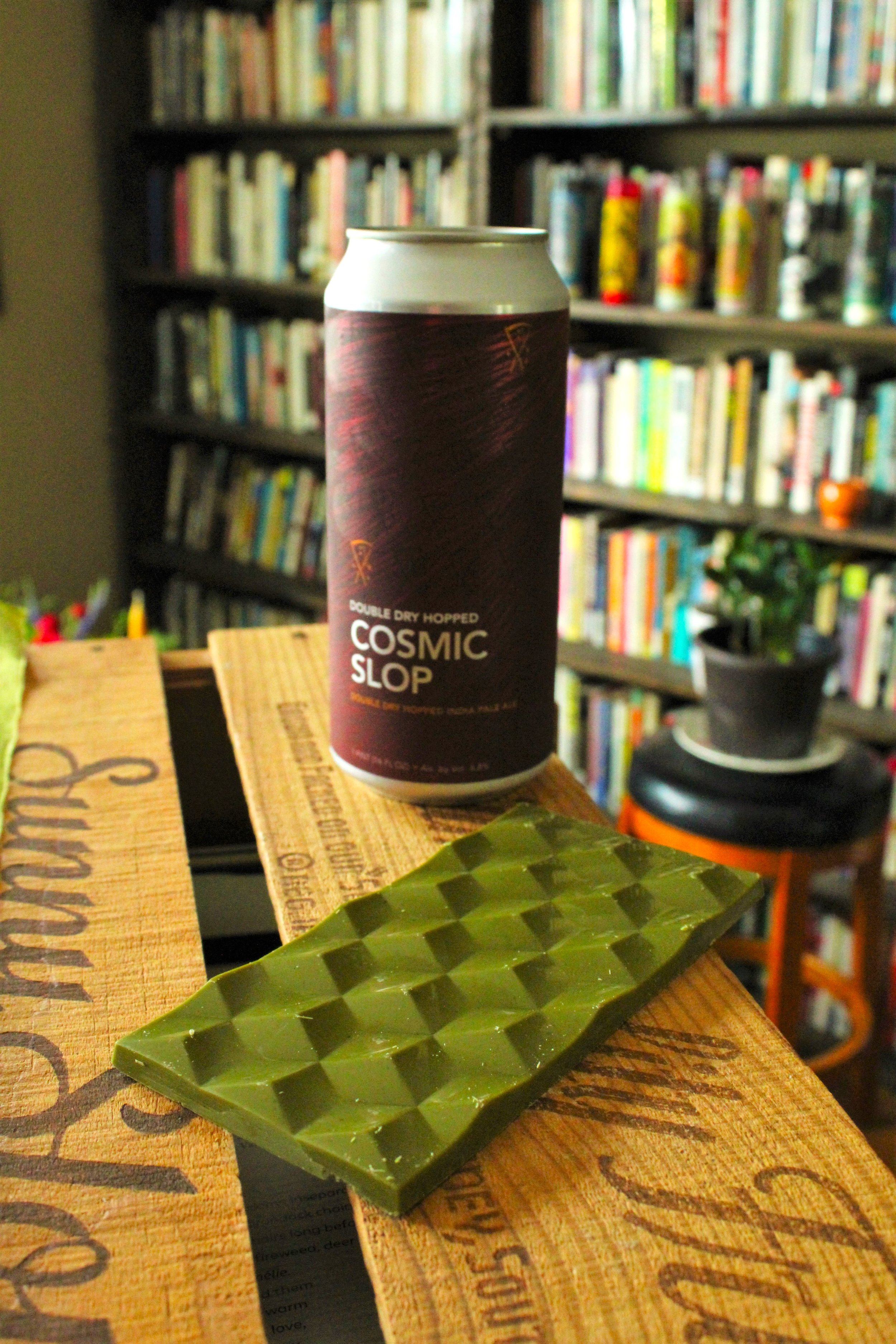How to Pair IPAs with Craft Chocolate
by David Nilsen
IPAs are the most popular family of beer styles in craft beer today. Walk into any brewery taproom, beer bar, or bottle shop, and you’ll likely be confronted with numerous IPA options, including IPAs in different substyles. These beers exist largely to showcase the character of hops, the little leafy green flowers that come in a range of varietals and deliver a dazzling array of flavors and aromas to beer. At their best, IPAs are a beautiful expression of creativity and execution both in agriculture and brewing.
But IPAs are not the first beers most people think of for pairing with craft chocolate.
Chocolate is made from cacao, the bean of a tropical tree. After being harvested and fermented, cacao beans are roasted in a process very similar to how dark malts are roasted, which is one of the reasons Porters, Stouts, and other styles made with these dark malts often have chocolatey flavors. Because of this, those darkers styles have flavors that tend to easily complement chocolate, and they’re the first styles people tend to reach for when pairing with their favorite bar.
Porters and Stouts can certainly pair very well with craft chocolate, but there’s a world of other beer styles that can pair with the right bars with just a little bit of planning and attention. Often, these styles can yield eye-opening and mouth-watering surprises. IPAs are a great example.
While IPAs can pair beautifully with craft chocolate, it’s not an effortless pairing. IPAs present challenges that can lead to chocolate pairings with harsh, bitter, astringent, and/or clashing flavor qualities. In this guide, we’ll look at some common styles of IPA, discuss their sensory attributes, and discuss chocolates to seek out and chocolates to avoid when planning pairings with each.
Hazy IPA
Brief Background
Over the last decade, after many years of quite bitter (but often delicious!), love-them-or-hate-them IPAs, drinkers were introduced to a family of styles that celebrates hop flavor and aroma without (usually) extracting as much hop bitterness. Hazy IPAs took over craft beer in the mid-2010s, and are now the most popular style in craft beer. They are sometimes referred to as New England-style IPAs.
Flavor
Hazies are all about showcasing hop aromas and flavors, which can include tropical and citrus fruits, herbal and floral notes, and a range of more esoteric descriptors ranging from diesel to Riesling. Their soft bodies and [usually] lower bitterness than old school IPAs allow those flavors to shine. Gentle malt flavors of pale bread or cracker offer some gentle sweetness to support these hop flavors. The strains of ale yeast used to ferment these beers can contribute some mild fruitiness, but this will likely be difficult to distinguish from the more aggressive hop fruitiness.
Variations
Click to order the Pairing Beer & Chocolate book!
Hazy IPAs are the standard bearer of this group, and range from 6 - 7.5% ABV, with the aforementioned assertive hop character. Hazy Double IPAs are generally over 7.5% ABV and are bolder still. Some brewers brew very strong examples and call them Triple IPAs, though past a certain point it’s all just code for “strong and bold”. As with all styles, different brewers will interpret these distinctions slightly differently.
Milkshake IPAs are a variant generally made with lactose, fruit, and occasionally vanilla. These beers are creamy in texture and often have at least the impression of sweetness. Some are cloying and flabby, some are well-executed and allow fruit and hops to interact beautifully. Their intensity of fruit flavor and ample sweetness make them surprisingly versatile for pairing with inclusion bars.
Pairings
Challenges
Though pleasant, the flavors in these beers are bright and bold, so when they don't work with a chocolate, they really don't work. To crib a line from Longfellow, when these pairings are good, they are very, very good, but when they are bad they are horrid. Hop bitterness is the biggest variable in planning these pairings, and unfortunately, the bitterness of the beers in these Hazy styles varies widely, from barely there to quite bracing. Read a brewery’s descriptions of a given beer to get a sense for how bitter an example is, or do a test tasting first. (Note: While this guide is for IPAs, the same guidance can be applied to Hazy Pale Ales.)
Seek Out
You want to combine the dominant fruit flavors in these beers with a white or moderate percentage dark chocolate that features complementary spices or herbs. Occasionally, a contrasting fruit can work as well. Bars with chili can potentially work so long as they aren’t too hot, the hop bitterness of the beer isn’t too high, and there is some underlying sweetness to the bar.
Avoid
The majority of single origin dark bars and anything notably acidic. Any overly bitter inclusions.
Examples
Branch & Bone Cosmic Slop from Dayton, Ohio, is packed with sweet, juicy tropical fruit notes—peach creamsicle, mango, pineapple, papaya—in a creamy body with moderate underlying bitterness. These flavors combine with the green tea and citrus notes of Miette et Chocolat's Matcha Citron white bar to create the impression of a fruity white wine sangria garnished with fresh sprigs of thyme and oregano.
Troegs Perpetual Haze IPA from Pennsylvania has a soft nose of sweet orange, grapefruit, and mango, with tropical flavors of mango and pineapple and just a curve of mandarin orange peel, with moderate bitterness.
I wanted to complement this with a bolder citrus note against those tropical flavors, and went with Baiani Orange Zest, a 70% dark chocolate. The woody, earthy cacao tamed the fruit notes in the beer into more of an old school IPA pine-like flavor, creating a unique combination of pine and orange that was quite pleasant. The beer provides a nice concluding bitterness over the chocolate’s light sweetness.
Balanced, Malty IPAs
Brief Background
British IPAs were first brewed around the turn of the 19th century, but we’re not going to dig into that well-trod history today. British IPAs inspired the first IPAs of the craft beer movement in the U.S. in the late 1970s and early 1980s, an influence still seen today in styles like Midwest IPA, Red IPA, and maltier versions of Double IPA. Before the emergence of Hazies, these were the most popular styles in craft beer.
Flavor
These styles showcase notable hop aroma, flavor, and bitterness, but support those characteristics with ample malt foundations and varying levels of fermentation character. The individual substyle will influence the specifics of balance and malt flavor.
Variations
In a previous era of craft beer, most beers labeled “American IPA” would have fit in this category, but that term can now represent a range of styles. Midwest IPAs (either in name or spirit—yes, this can get confusing) have notable malt flavors that can include caramel and toast, elevated hop bitterness, and any range of hop aroma and flavor, though citrus and pine are pretty classic. Red IPAs are similar, but with richer malt flavors that can include dark caramel, toast, and dark fruit (note: some Rye IPAs can fit here as well, though some examples are quite dry and/or bitter). British IPAs will have moderate hop bitterness, but hop aroma and flavor will generally lean more floral, herbal, or lightly citrusy.
Pairings
Challenges
The elevated bitterness in these beers can pose significant problems when it comes to finding the right chocolate. Any bar that amplifies that hop bitterness and/or fails to pull forward the beer's malt and/or fermentation flavors (or, to a lesser degree, the beer's sweeter-leaning hop aromas) will lead to offputting harshness. (Note: the general guidance in this section can also apply to American Pale Ale, American Amber Ale, English Bitters, American Strong Ale, and California Common).
Seek Out
Caramel is a champ here. Look for bars with actual caramel or similar inclusions (honey, toffee, malted milk, etc) to harmonize with and pull forward the underlying malt flavors of the beer. This will swing the pairing's balance toward a sweet perception, which will slightly amplify the beer's [potential] subtly fruity fermentation notes and the sweeter-reading fruit aromas of the hops. This can include white, milk, or dark bars, provided those criteria are met. Any flavors or inclusions that harmonize with those hop notes (e.g. ginger with orange-like hop aromas) will help.
Avoid
Any high percentage dark bars or bars with inclusions that will amplify the beer's bitterness (sharp spices or bold coffee, etc). Any bar that fails to link up with the beer's malt flavors as described above, as this will leave the hop bitterness alone on an island and increase the bitter perception.
Example
Bell’s Two Hearted Ale from Michigan is a classic Midwest-style IPA with lightly sweet malt flavors supporting orange-forward Centennial hop flavors and moderate bitterness. This makes a great pairing for the milky, caramely flavors of French Broad’s best-selling Malted Milk 45% bar. The chocolate is made with malt powder from Riverbend Malt House, and the milky caramel notes sync up with the deeper caramel malt of the beer to create layers of luxurious, creamy caramel held in a regal, bitter frame by the hops. The old school American hop notes in the beer lend a touch of candied orange to the dominant caramel.
Black IPA
Brief Background
Black IPA is a subset of IPA that uses debittered dark malts to give a subtle roast impression, but without the roast intensity of most Porters and Stouts. The style became a bit of a fad in the early 2010s. It receded in popularity, and has now settled into a more modest but steady niche popularity. The style is sometimes referred to as Cascadian Dark Ale.
Flavor
Black IPAs balance the subtle roast mentioned above with classic American or Pacific hop aromas—pine and citrus most commonly, though tropical fruit notes can sneak in—and moderate to quite high hop bitterness.
Pairings
Challenges
The curve ball here is the elevated hop bitterness of these beers, along with their lack of much (if any) sweetness. That hop bitterness can quickly become harsh if it is met with astringency or elevated bitterness in the chocolate. (Note: pairing guidance in this section can also potentially apply to Brown IPAs and boldly hoppy Porters and Brown Ales.)
Seek Out
Lower percentage dark chocolate with a creamier or sweeter impression, white, milk, and lower percentage dark bars with gentle herbal or tea inclusions, white, milk, and lower percentage dark bars with low acidity, sweeter fruit inclusions like coconut.
Avoid
Higher percentage dark chocolates or dark bars with elevated bitterness or astringency. Bitter and bold spice or herb inclusions.
Example
Heavier Than Air Method of Edge Waves in the Physical Theory of Diffraction Cascadia Dark Ale (whew, that’s a mouthful) is a 7.6% Black IPA from Centerville, Ohio. Flavors of dark-chocolate covered pine needles and toasted dark grain lead to elevated hop bitterness and bitter pine resin.
Primo Mountain Cardamom is a 60% vegan dark mylk bar made with coconut milk and green cardamom. It tempers the bright, sharp cardamom with layers of sweet coconut and milk chocolate.
Together, the chocolate and coconut foundation fills out the dark malt flavor of the beer and tamps down the hop bitterness long enough to allow the cardamom and pine notes to create a delightful forest bouquet. Eventually the piney bitterness comes back to the fore.
Other Styles
There are a handful of IPA styles that consistently prove difficult to pair well with chocolate. Styles that are dry and bitter, with little malt flavor, will be all but impossible to find good pairings for. You can try—let me know if you find exceptions!—but there is likely to be a lot more disappointment than satisfaction down this road. This includes West Coast IPA most notably, though IPLs and the emerging Cold IPA style can also prove difficult.
There are other substyles of IPA that are rarely seen these days, such as White IPA and Belgian IPA. We’ll save those for another post.





